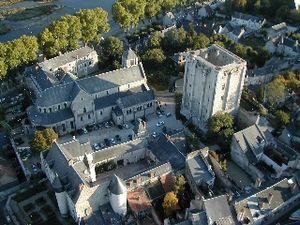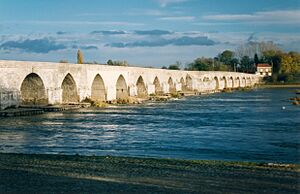Battle of Beaugency (1429) facts for kids
Quick facts for kids Battle of Beaugency |
|||||||
|---|---|---|---|---|---|---|---|
| Part of the Hundred Years' War | |||||||

|
|||||||
|
|||||||
| Belligerents | |||||||
| Commanders and leaders | |||||||
The Battle of Beaugency was an important fight during the Hundred Years' War. It happened on June 16 and 17, 1429. This battle was part of a big push by the French army, led by Joan of Arc. They wanted to take back land along the Loire River in France. This victory came right after they successfully ended the Siege of Orléans.
Contents
Why Beaugency Was Important
Beaugency was a small town in central France. It was located right on the northern side of the Loire River. This town was very important because it had a bridge. Controlling this bridge meant controlling a key way to move supplies and soldiers.
A few years before, the English had taken Beaugency. They planned to use it as a starting point to invade southern France. But the French army attacked and took back the town and its bridge. This gave them a vital path for their summer attacks in the north. It also helped prepare for the crowning of King Charles VII of France.
The Loire Campaign
The French army had a plan in 1429 called the Loire campaign. It included five main battles:
- The Siege of Orléans
- The Battle of Jargeau
- The Battle of Meung-sur-Loire
- The Battle of Beaugency
- The Battle of Patay
By the end of 1428, most of France north of the Loire River was under foreign control. The bridge at Orléans had been destroyed. The French had lost control of all other river crossings. But three quick battles at Jargeau, Meung-sur-Loire, and Beaugency changed everything. These wins showed that the French were confident again. They also set the stage for future French attacks on Rheims and Paris. The Loire campaign also led to many English commanders being killed, captured, or shamed. It also greatly reduced the number of skilled English longbowmen.
A New Ally Joins
After the victory at Orléans, more and more French people joined the army. During the attack on Beaugency, a volunteer caused a stir. This was Constable Arthur de Richemont. He had been out of favor with the king for two years. But he showed up with 1,000 men and offered to help. Even though it risked angering the king, Joan of Arc accepted his help.
How the Battle Happened
Joan of Arc and Duke John II of Alençon led the French forces. Their army included important captains like Jean d'Orléans, Gilles de Rais, Jean Poton de Xaintrailles, and La Hire. John Talbot, 1st Earl of Shrewsbury led the English defense.
The French army did something different. After capturing the bridge at Meung-sur-Loire on June 15, they did not attack that town. Instead, they attacked Beaugency the very next day. This was different from the usual way of fighting sieges back then.
Unlike Meung-sur-Loire, the main English stronghold at Beaugency was inside the city walls. This strong castle still stands today. On the first day of fighting, the English left the town. They retreated into the castle. The French then used their cannons to fire at the castle. That evening, de Richemont and his men arrived.
The French leaders heard that an English relief force was coming from Paris. This force was led by Sir John Fastolf. So, d'Alençon quickly talked with the English. He negotiated their surrender. He allowed them to leave Beaugency safely. The very next day, on June 18, the Battle of Patay took place in open territory.
See also
- Beaugency
- Medieval warfare


